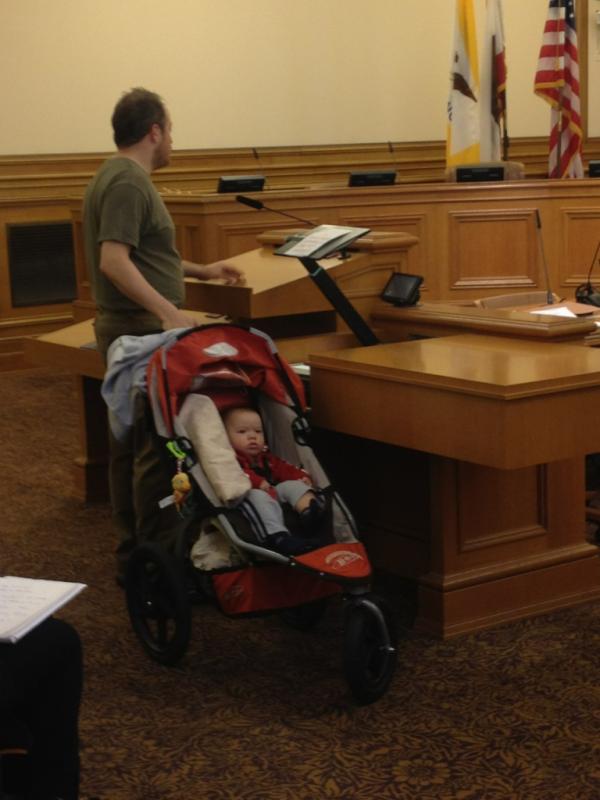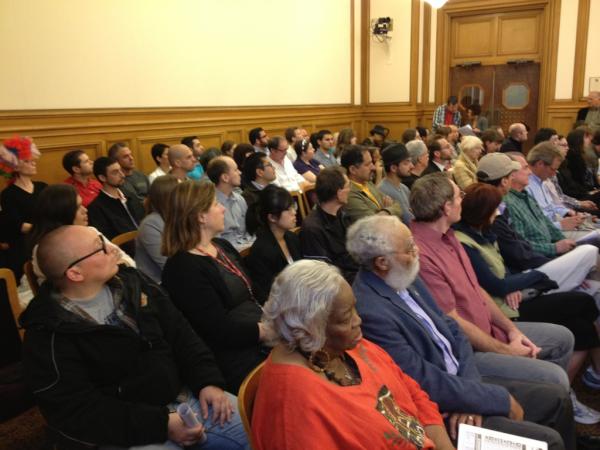Nearly 100 attendees packed a City Hall room this morning for a hearing on the Fell and Oak bikeways, where supporters of the project overwhelmingly outnumbered detractors.
Dozens of speakers, young and old, said the project was vital for improving the safety of people who already bike as well as those who will only feel safe riding with the separated bike lanes.
"The three blocks of terror, as I call them, really have been a big impediment to me biking in San Francisco," said Julia Uota, who lives in the Richmond. "I am new to biking, and I'm terrified to bike Fell Street on my way home. During rush hour, I make it a point of getting off my bike and walking as a pedestrian on the sidewalk, where it's not really wide enough to have a bike next to me."
D5 Supervisor Christina Olague told hearing officers: "My office hears from people who ride bicycles through this area, including parents biking their children to school, people biking to shop on Divisadero, and people of all ages biking to work. We must prioritize this kind of project and safety improvements, I believe, in our district."
Although SFMTA staff said they couldn't approve the project for recommendation until the environmental review is finished, it's expected to go to the SFMTA Board of Directors in the fall or winter. Staff said the project could return for another public hearing for official recommendation to the board, depending on the changes in the finalized designs, which would be informed by the comments at today's hearing.

The relatively few opponents of the project repeated complaints about removing car parking, and called for bicyclists to instead be routed onto neighboring Hayes and Page Streets, despite explanations from agency staff and pro-bikeway speakers that steep grades and extra distances already deter riders from using them.
A few project supporters said the SFMTA went too far trying to mitigate the loss of car parking. They criticized the agency's proposal to create roughly 60 new parking spaces on other streets to offset the 103 that would be removed to make room for the bike lanes, citing the adverse impacts. Under the current plan, three bus stops on Hayes would be removed, which the agency will help speed up service on the 21 Muni line. However, some complained of having to walk farther to reach their bus stop, and a few speakers said it makes more sense to remove the stop at Lyon Street rather than the adjacent one at Central Street, since Central appears much more heavily used. Staff said it chose to keep the Lyon stop to avoid inconveniencing the residents of a senior housing center it fronts.
About 43 other spaces would be created by converting parallel parking lanes to perpendicular and angled parking on nearby streets, but a few commenters said perpendicular parking is difficult to use and is an eyesore.
Luis Montoya, project manager for the SFMTA, said the details of the final design could be adjusted based on the comments, but that the project is necessary to meet the city's goal of achieving 20 percent bike mode share by the year 2020.
"The city has a transit-first policy in which we will prioritize transit and bicycle improvements over those of the personal automobile, so with those goals in mind, we're trying to create a project that minimizes the negative impacts to the community," he said.
Neal Patel, community planner for the SF Bicycle Coalition, praised the SFMTA's community outreach and planning process. "I have never participated in a community process that was as well attended and where the community was as engaged as this one," he said. Handing a thick stack of support letters to the hearing officers, he noted that despite the harrowing conditions on Fell and Oak, there are already 1,500 to 2,000 people biking on Fell Street each day.
"That's a lot -- it's one of the highest in the city," said Patel. "I think it's the responsibility of the MTA to improve safety for those people."





